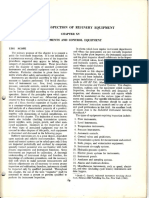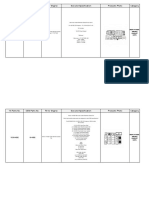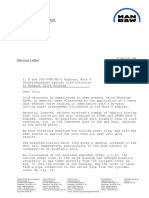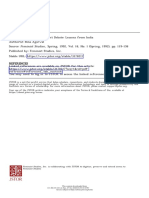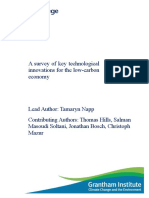BT-69 MSDS Eng
BT-69 MSDS Eng
Uploaded by
mehmetCopyright:
Available Formats
BT-69 MSDS Eng
BT-69 MSDS Eng
Uploaded by
mehmetOriginal Description:
Original Title
Copyright
Available Formats
Share this document
Did you find this document useful?
Is this content inappropriate?
Copyright:
Available Formats
BT-69 MSDS Eng
BT-69 MSDS Eng
Uploaded by
mehmetCopyright:
Available Formats
Since 1980
MATERIAL SAFETY DATA SHEET
PROSES
PAGE 1/4
BT-69 CLEANER SPRAY 500 ML NDT REVISION DATE : 05.07.2011
This data sheet has critically important informations. Therefore, BETA PROSES recommended to read this
MSDS document from first phrase to last phrase. If you need to use this material for the testing, you have to
consider the precautions that are written on this data sheet and have to apply them before using of our
product.
1. DESCRIPTION OF THE PRODUCT AND THE COMPANY
COMMERCIAL NAME : BT-69 CLEANER SPRAY 500 ML
COMPANY TITLE : BETA PROSES ÖZEL KİMYASALLAR SAN.VE TİC.LTD.ŞTİ.
Hoşdere Mevkii Isıso San.Sitesi V-2 BLOK N.9 Esenyurt iSTANBUL
TELEPHONE : 00 90 212 - 6231854
FAX NUMBER : 00 90 212 - 6231858
EMERGENCY TELEPHONE : 00 90 212 - 6231856
USING AREA OF THE PRODUCT : Industrial
2. .INFORMATION ABOUT MATERIAL AND ITS COMPONENTS CAS NO EINECS NO
%W / W
CHEMICAL NAME : ALIPHATIC HYDROCARBON SOLVENT 60-70 64742-49-0 265-151-9
CHEMICAL NAME : LIQUEFIED PETROLEUM GAS 30-40 68476-85-7 270-704-2
3. INFORMATION ABOUT DANGER OF THE MATERIAL CONTENT
Aliphatic hydrocarbon solvent
Human Health: : It's not poisonous, If it's breathe for a long time it can be prevented the breathing. When it
contacts with skin for a while, it degreases of the skin and causes to get dry.
Effect on Environment:It's not harmful for the ozone layer. If it is poured on the ground , it shows harmful effect
on the plants. It does not dissolve in the water. It doesn't cause to any damage on ground and water creatures.
Chemical and physical dangerous: Flammability or explosion: It is flammable.
Classification: It's classified in flammable materials.
Liquefied Petroleum Gas Human health: Its not poisonous, if it s breath for a long time, it can cause to silicosis disease.
Effect on Environment:It doesn't cause to any damage on ground and water creatures.
Flammability or explosion:Flamamable and flashable gas. Explosion boundaries in air is % volume 1.2/7.5
Classification: It's classified in flammable and flashable materials.
FLAMMABILITY
TOXICITY
HARMFUL TO HUMAN HEALTH
OZONE DEPLETING
ENVIRONMENTAL DAMAGES
MIN:0 LOW:1 MEDIUM:2 HIGH:3 MAXIMUM:4
Since 1980
MATERIAL SAFETY DATA SHEET
PROSES
BT-69 CLEANER SPRAY 500 ML NDT PAGE 2/4
REVISION DATE : 05.07.2011
4. FIRST AID MEASURES:
If it is breath for a long time: The person who has breath it for a long time must be taken out to the open-air. In the situations of swoon
and dyspnea, the doctor must be called. If it is needed, the oxygen gas must be given to the sick.
If it contacts with the skin for a while: The contact area must be washed with soapy water. If this is not enough to
heal, the doctor must be called.
If it contacts with the eyes: Inside of the eye msut be washed with water, ir this not enough to heal the doctor
must be called.
In situation of swallowing: Do not make the sick vomit, Make the patient drink one glass of water or one glaas of milk and call upon the
doctor immediately.
5. FIRE FIGHTING MEASURES
Fire extinguisher materials: Carbondioxide containing foam extinguishers, dry extinguishers and sand.
Unavailable extinguishers: Water.
Appropriate Equipments: Wear the protective fire clothes (fire helmet, fire pants, fire boots and neoprene fire gloves), gas mask.
Decompose materials which arised at fire situation: Carbondioxide(CO2), decomposed carbon containing compounds.
Fire extinguishing Procedures: Provide the vacation of fire area, do not permit the entering of anyone who is not related with the
fire extinguishing. Take position against the wind. Stay away from the low places that dangerous gases accumulate densely. Until the
extinguishing of fire completely and until the refiring risk is certainly done, spray the water spray to exposed vessels and effected areas
from the fire in order to cool them. Send away the flaming materials from the firing area with spraying the water on them to protect the other
people from fire.
6 . ACCIDENTAL RELEASE MEASURES
Personal precautions: Especially, small and close fitting places must be aerated often, If so much leakage has occurred, oxygen gas mask
with the positive pressed must be wear. Take position in front of the wind and gas leakage. I mean, the wind and gas leakage must be left at
your backside. Do not take position against the wind and gas leakage. Send away the materials which can cause to fire.
Cleaning Methods:It must be aerated, clean accumulated dry powders from the floor surface and remove the dense gases from the working
area, : It must be washed with water.
Precautions about protection of the environment: Prevent the leakage of the material into the water carriers.
7. USING AND STORAGE
Using precautions: Aerate the using area, do not brathe it for a long time, do not apply it on the open-fires and hot things or hot places,
do not contact with material by skin and by clothes directly, do not eat anything or smoking during the working.
Storage:Do not storage it in the moist areas,do not storage it with oxidize and corrosive materials together,do not storage it with flammable
materials together, stay it away from the sunlight and storage it at the cool and clean places.
Package: In pressed aerosol tubes
Shelf life: 3 years.
Since 1980
MATERIAL SAFETY DATA SHEET
PROSES
PAGE 3/4
BT-69 CLEANER SPRAY 500 ML NDT REVISION DATE : 05.07.2011
8. EXPOSURE CONTROL AND PERSONAL PROTECTION
Name CAS numbers Exposing limits
Aliphatic Hydrocarbon Solvent 64742-49-0 2000 ppm.
Liquefied Petroleum Gas 68476-85-7 1000 ppm.
Personal protection devices:
Breathing: Do not breath the vapour of the material, aerate the using area, in the long time usage and in closed working places wear gas
mask definitely.
Skin and hands: Wear the gloves that exhibit resistance to chemicals, wear the daily working clothes.
Protection of eyes/face: Wear the protective glasses against the chemicals, Protective glasses must be matched with EN 166 or equal
standing standarts.
Do not contact with the material directly and for a long time, do not contact with the material again and again, do not work alone in closed
airless places, be careful about slippery ground and be careful about the temparature difference between testing surface and working area
against teh risk of flame.
9. PHYSICAL AND CHEMICAL PROPERTIES
PRODUCT
Physical state : Liquid
Color : No color
Smell : Characteristic light
PH : It cannot be measured because it is insoluble..
Flash point : - 20ºC
Oxidization Capability : It's not an oxidized material
Density ( 25ºC ) : 0,75 g/ml
Dissolution : Cannot dissolve in the water, dissolves in the organic solvents
Liquefied Petroleum Gas
Flash point: < 0 C
10. STABILITY AND INTERACTION
Stability : At apparopriate storage conditions it is stable.
Interaction : No
Dangerous decomposition products: CO + CO2
11. TOXICOLOGICAL INFORMATION
Acute: It is not carcinogen and cancerogen.
Local Affects: If the worker has taken precaution during working, it doesn't cause iiritations on trachea.
If the worker is exposed to high con centration of the material for a long time, it causes to irritation on mucosa memrane, it can cause to
easy or mediocrity skin irritations, it can degreases the oil of skin and can cause to skin dryness.
In the eyes it can cause to heavy irritations.
If it is swallowed, it can cause heavy irritations,but it does not cause any toxic affect
If it is breath for a long time, it can form dyspnea situation.
Since 1980
MATERIAL SAFETY DATA SHEET
PROSES
PAGE 2/4
BT-69 CLEANER SPRAY 500 ML NDT REVISION DATE : 05.07.2011
12. ECOLOGICAL INFORMATION
To Destroy: According to the local rules it can be destroyed by using physical and chemical methods.
Permanence: Unknown
Ecologic Toxicity: If it is poured on plants, it is harmful for them.
13. WASTE INFORMATION
Destroying of the product: it is fired according to the local rules
Destroying of the package: Do not throw empty aerosol tubes on fire, with opening a small hole on the valve crock to pump out all of the
gas completely, be sure all of the gas is pumped out and then. send tubes to the related factories for recycling or the legal waste collection
system.
14. TRANSPORTATION INFORMATION
Land route and sea route transportation ( ROAD/RAIL ADR/RID )
Class 2 Division 2.1 UN-NO:1950 Labels :Aerosols Packing Group:None
Sea route transportation(IMDG Code:UN n)
UN-NO:1950 ,Class 2 Division 2.1 ,IMDG PAGE NO2102,EmS nO:2-13 Labels :Aerosols Packing Group:None
Air route transportation (IATA : ONU n)
1011 cl.2.1 UN-NO:1950 Class 2 Division 2.1 Labels:Aerosols, Flammable Packing Group:None
15. REGULATION INFORMATION
EEC Classification and labelling method
R:12 Extremely flammable
S: 9 Keep container in a well-ventilated place
S:16 Keep away from sources of ignition - No smoking
S:33 Take precautionary measures against static discharges
S:24 Avoid contact with skin
S:25 Avoid contact with eyes
S:26 In case of contact with eyes, rinse immediately with plenty of water and seek medical advice
16. OTHER INFORMATION
This material safety data sheet is prepared in accordance with EEC regulations. The people who use this product directly or indirectly,
distrubutors of this product have to read this material safety data sheet carefully and have to understand what written in this document.
The responsibility of reading and understanding of the material safety data sheet relates to buyer person or buyer company.
The informations and directives in the material safety data sheet rely on the scientific and technical informations which their date written
in the material safety data sheet. Beta Proses Special Chemicals Industrial and Commercial Limited Company is not responsible from
any occuring bad situation which is sourced from lack of the scientific and technical informations thus far the written date in the material
safety data sheet.
BETA does not recommend the using of this product at below signified conditions:
Possibility of the mixing with sand or underground waters (on the ground, in washbasin, in canalization, in septic tanks) – possibility of
exposure for a long time (small rooms, closed areas, insufficient aerated places) – possibility of contanct eith the skin (in removing of
sticky band from the skin, in cleaning of the hands from oil and grease ) – in directly contact with the foods and drinks – in vaporization
in flammable temparature interval – in the places where are removing of the waste can form a risk for environment or health.
CHEMICAL ENGINEER
Kadriye Nebioğlu
You might also like
- Iso 1133-1-2022Document34 pagesIso 1133-1-2022mehmet100% (5)
- Astm E384-22Document40 pagesAstm E384-22mehmet100% (7)
- Water Electrolysis For Hydrogen Production (Pasquale Cavaliere) (Z-Library)Document852 pagesWater Electrolysis For Hydrogen Production (Pasquale Cavaliere) (Z-Library)irisqu2No ratings yet
- Iso 4136-2022Document16 pagesIso 4136-2022mehmet100% (3)
- Astm A370-22 PDFDocument51 pagesAstm A370-22 PDFmehmet100% (1)
- Iso 1920-7 PDFDocument30 pagesIso 1920-7 PDFmehmetNo ratings yet
- Formula Sheet Final Exam Fluid Mechanics PDFDocument4 pagesFormula Sheet Final Exam Fluid Mechanics PDFALBERTONo ratings yet
- Operating Instruction For Synchronous GeneratorDocument16 pagesOperating Instruction For Synchronous GeneratoriuliiulianNo ratings yet
- Infoprd-Geomet 500-gb PDFDocument2 pagesInfoprd-Geomet 500-gb PDFSannohashi MFGNo ratings yet
- BT-68 MSDS EngDocument4 pagesBT-68 MSDS Engmehmet100% (2)
- BT-70.S MSDSDocument4 pagesBT-70.S MSDSmehmetNo ratings yet
- BT-68 MSDS EngDocument4 pagesBT-68 MSDS Engmehmet100% (2)
- Rta-14 1Document8 pagesRta-14 1George DomusciuNo ratings yet
- RTA-42 - 1 - Templates For Exhaust Valve Seat and SpindleDocument6 pagesRTA-42 - 1 - Templates For Exhaust Valve Seat and Spindledhilip87No ratings yet
- GBT 34001-2016 China Ship Repairing Quality StandardDocument176 pagesGBT 34001-2016 China Ship Repairing Quality StandardMgZinNo ratings yet
- 350 - Survey ULJ S50C 03 1Document8 pages350 - Survey ULJ S50C 03 1Gaurav WaliaNo ratings yet
- High Temperature Corrosion Exh ValvesDocument6 pagesHigh Temperature Corrosion Exh ValvesCvita CvitićNo ratings yet
- Hhi HSM SL 14 001Document15 pagesHhi HSM SL 14 001PranabNo ratings yet
- IKO Spherical Bushes PDFDocument14 pagesIKO Spherical Bushes PDFMari selvamNo ratings yet
- ABB Turbo TPL-C AssemblingDocument24 pagesABB Turbo TPL-C AssemblingsbNo ratings yet
- 04 02 PDFDocument36 pages04 02 PDFIgor Ivanovski100% (1)
- Cooling Water and Additives For WinGD Engines v4Document9 pagesCooling Water and Additives For WinGD Engines v4Prabin 7906No ratings yet
- L27-38 GenSet TierIIDocument1,132 pagesL27-38 GenSet TierIIartemio CardosoNo ratings yet
- Inspection Instrument&Control EquipmentDocument43 pagesInspection Instrument&Control EquipmentModesty100% (1)
- MWSN 111 02eDocument5 pagesMWSN 111 02eMarcin LosyNo ratings yet
- MarelliMotori A4C 180 L4Document48 pagesMarelliMotori A4C 180 L4superspif100% (1)
- Sc100 Combination PH-OrP Analysis System User ManualDocument52 pagesSc100 Combination PH-OrP Analysis System User ManualSeby DeacNo ratings yet
- Deutx 914 Operation and Maintenance Manual AbbyDocument83 pagesDeutx 914 Operation and Maintenance Manual AbbyTASHKEEL50% (2)
- ZULFI E 7018: Brand Name & Classification Approvals GradeDocument1 pageZULFI E 7018: Brand Name & Classification Approvals GradeadnanNo ratings yet
- Chemical Storage 8th Sept 2010Document1 pageChemical Storage 8th Sept 2010thirdNo ratings yet
- Product Manual 26114 (Revision J) : SOGAV™ Solenoid Operated Gas Admission ValveDocument40 pagesProduct Manual 26114 (Revision J) : SOGAV™ Solenoid Operated Gas Admission ValveVitaliyNo ratings yet
- KT EVO Data Sheet EDocument1 pageKT EVO Data Sheet EAndy Kong KingNo ratings yet
- MAN-Service Experience Small Bore Four-Stroke Engines PDFDocument20 pagesMAN-Service Experience Small Bore Four-Stroke Engines PDFvangeliskyriakos8998No ratings yet
- ESAB Welding and Cutting CatalogueDocument76 pagesESAB Welding and Cutting CatalogueFilipe Cordeiro100% (1)
- RTA-37.1 Reconditioning of Piston RodsDocument11 pagesRTA-37.1 Reconditioning of Piston RodsCatalin Cata100% (1)
- Catalogue - DingZing DZ Seals Catalogue-E-SDocument49 pagesCatalogue - DingZing DZ Seals Catalogue-E-SPhạm Hoài AnhNo ratings yet
- Jis G 3456 - 2004-Stpt-Carbon Steel Pipe For Hight Temp. ServiceDocument26 pagesJis G 3456 - 2004-Stpt-Carbon Steel Pipe For Hight Temp. ServiceDương HoàngNo ratings yet
- 2 (b2 4) TurbochargerDocument158 pages2 (b2 4) Turbochargerxahterkot159No ratings yet
- VODCDocument2 pagesVODCVineet Maheshwari100% (1)
- Doc. No. 08 - 42 21 SP070 - CODocument32 pagesDoc. No. 08 - 42 21 SP070 - COGanantaEgas Wahyu EndriantoNo ratings yet
- Data Sheet 150x100 FS2KA 5 90Document5 pagesData Sheet 150x100 FS2KA 5 90Andreas B KresnawanNo ratings yet
- BR TempSens enDocument28 pagesBR TempSens enCalandrasReyCalandrasreyNo ratings yet
- Marine Installation Manual: Issue 2020-06Document185 pagesMarine Installation Manual: Issue 2020-06Thein MaungNo ratings yet
- SX Spare Part CatalogueDocument413 pagesSX Spare Part Catalogueزياد محمدNo ratings yet
- 3K Pump 26.2.2015Document65 pages3K Pump 26.2.2015TamNo ratings yet
- Aeb 1FDocument12 pagesAeb 1FGustavo ZavalaNo ratings yet
- LHE型錄Document35 pagesLHE型錄Antonio Benítez LópezNo ratings yet
- Jaquet T 501 ManualDocument59 pagesJaquet T 501 ManualSanthosh Reddy BNo ratings yet
- M1-6 With BHPDocument33 pagesM1-6 With BHPVinay Kumar Neelam100% (1)
- 〈BGW N〉E991 1303 08Document101 pages〈BGW N〉E991 1303 08richiNo ratings yet
- E-P Control Valve InstructionsDocument25 pagesE-P Control Valve InstructionsYuriiNo ratings yet
- 2130 Alfa Laval Separator ModuleDocument874 pages2130 Alfa Laval Separator Module3engQuartzNo ratings yet
- Curve Xtreme 100 4K UHD User ManualDocument37 pagesCurve Xtreme 100 4K UHD User ManualjksankarNo ratings yet
- PVM 74 EtonDocument48 pagesPVM 74 Etoncaprit_her_771605No ratings yet
- Mercruiser Engine Gasket SetsDocument4 pagesMercruiser Engine Gasket SetsJSMarine Parts China100% (1)
- LeroySumer LSA 47.2Document12 pagesLeroySumer LSA 47.2Paneendra Kumar100% (1)
- SL96-341 B&W Service LetterDocument4 pagesSL96-341 B&W Service LetterkamalNo ratings yet
- Pci 413Document3 pagesPci 413Wing On WongNo ratings yet
- Tech Water PumpDocument2 pagesTech Water PumpRafael100% (1)
- Cus 312 EDocument2 pagesCus 312 ECocoi SolisNo ratings yet
- Alfa Laval Tank WashingDocument463 pagesAlfa Laval Tank WashingmariodalNo ratings yet
- Wartsila Vasa 32 - Service Letter - Camshaft Driving Gear & Intermediate WheelsDocument2 pagesWartsila Vasa 32 - Service Letter - Camshaft Driving Gear & Intermediate Wheelsswiatekpiotrwp.plNo ratings yet
- Рогалев, ЧернявскийDocument8 pagesРогалев, ЧернявскийТимур Казыханов100% (1)
- Uni 5737 - Din 931 - en Iso 4014Document27 pagesUni 5737 - Din 931 - en Iso 4014ilroscioNo ratings yet
- Deflection Onboard Outfitting For Yanmar Engine Type 6EY26Document3 pagesDeflection Onboard Outfitting For Yanmar Engine Type 6EY26María Del Carmen Sandoval RodríguezNo ratings yet
- A - 15 Service Bulletin: 03.02.97 Technical Information To All Owners of Sulzer A Type Diesel EnginesDocument4 pagesA - 15 Service Bulletin: 03.02.97 Technical Information To All Owners of Sulzer A Type Diesel EnginesgeamuccioNo ratings yet
- Guideline For Reusable Parts and Salvage Operations: Inspection of Crankshafts For CracksDocument42 pagesGuideline For Reusable Parts and Salvage Operations: Inspection of Crankshafts For CracksPaul GustavoNo ratings yet
- SL00 383Document5 pagesSL00 383bekavacsNo ratings yet
- BT-10 MSDS EngDocument4 pagesBT-10 MSDS EngRamazan GÜLERYÜZNo ratings yet
- BS en 12300 - 2006 PDFDocument10 pagesBS en 12300 - 2006 PDFmehmetNo ratings yet
- Astm E290-2022Document12 pagesAstm E290-2022mehmet100% (2)
- A263-12 Stainless Chromium Steel-Clad PlateDocument6 pagesA263-12 Stainless Chromium Steel-Clad PlatemehmetNo ratings yet
- BS Iso 10636 - 1994Document13 pagesBS Iso 10636 - 1994mehmetNo ratings yet
- Asme-Ii-Part C-2013Document38 pagesAsme-Ii-Part C-2013rogersampaiocostaNo ratings yet
- 9th Grade Exploring LifeDocument99 pages9th Grade Exploring LifeYağız YiğitNo ratings yet
- Mahasiswa Mampu Menjelaskan Konsep Kuantisasi Energi: Kompetensi 1Document43 pagesMahasiswa Mampu Menjelaskan Konsep Kuantisasi Energi: Kompetensi 1Imam SyNo ratings yet
- Artem R. Oganov - High-Pressure CrystallogaphyDocument89 pagesArtem R. Oganov - High-Pressure CrystallogaphyYsam2No ratings yet
- Fuel Cell Electric VehicleDocument18 pagesFuel Cell Electric VehicleRohit Patil100% (1)
- Consumo Responsable InglesDocument2 pagesConsumo Responsable InglesMartin Gustavo Atocha MasiasNo ratings yet
- WEEK 3 ASSIGNMENT Cao Thi Anh DuongDocument5 pagesWEEK 3 ASSIGNMENT Cao Thi Anh Duongcascasduonh08No ratings yet
- Bina AgarwalDocument41 pagesBina AgarwalNisha DagaNo ratings yet
- Consequences of Global Warming:: 1. Melting of Glaciers: The Melting of Glaciers Will Create Plethora ofDocument5 pagesConsequences of Global Warming:: 1. Melting of Glaciers: The Melting of Glaciers Will Create Plethora ofNabarupa BoseNo ratings yet
- The Ideal Gas Law: Lecture 2: Atmospheric ThermodynamicsDocument16 pagesThe Ideal Gas Law: Lecture 2: Atmospheric ThermodynamicsAAKIL AHAMEDNo ratings yet
- Lesson Plan BiologyDocument8 pagesLesson Plan BiologyBiology &meNo ratings yet
- Coms343 Pre Lab 6Document3 pagesComs343 Pre Lab 6mae KuanNo ratings yet
- Acid Rain: Acid Rain Is A Rain or Any Other Form of Precipitation That Is Unusually AcidicDocument5 pagesAcid Rain: Acid Rain Is A Rain or Any Other Form of Precipitation That Is Unusually AcidicLucille BallaresNo ratings yet
- C7d2 Bonding Models DCNDocument14 pagesC7d2 Bonding Models DCNBaciu Florina GabrielaNo ratings yet
- Schauberger Viktor Dynamic Hydro PowerDocument8 pagesSchauberger Viktor Dynamic Hydro PowerAnibal Mussnìch Rodrigues100% (1)
- Professor Dr. M. Mahbubul AlamDocument5 pagesProfessor Dr. M. Mahbubul AlamEhsanul AzimNo ratings yet
- Environmental Degradation: A Case Study of Imbolo Mbue's How Beautiful We WereDocument5 pagesEnvironmental Degradation: A Case Study of Imbolo Mbue's How Beautiful We WereArunava MisraNo ratings yet
- Imperial College London Innovation For The Low Carbon EconomyDocument42 pagesImperial College London Innovation For The Low Carbon EconomyJAI SAHITHNo ratings yet
- Winter and Summer Air Conditioning: Design PrinciplesDocument100 pagesWinter and Summer Air Conditioning: Design Principlesvalerio.garibayNo ratings yet
- RP Combustion Methane LOXDocument38 pagesRP Combustion Methane LOXNisargPatelNo ratings yet
- End Sem Q PaperDocument2 pagesEnd Sem Q PapersantkabirNo ratings yet
- Papers: Drying of Dyestuffs and PigmentsDocument7 pagesPapers: Drying of Dyestuffs and Pigmentsblackshark432No ratings yet
- M 2 - Origin, Migration and Accumulation of PetroleumDocument10 pagesM 2 - Origin, Migration and Accumulation of PetroleumMohammad SalemNo ratings yet
- Outlook Temperature Humidity Windy Play: AS 0.0206 0.0053 Hence Play NoDocument1 pageOutlook Temperature Humidity Windy Play: AS 0.0206 0.0053 Hence Play NoHarshali PatilNo ratings yet
- InfiltrationDocument46 pagesInfiltrationglaydelleNo ratings yet
- Chemistry: Delhi Public School Ruby Park, Kolkata Class - XIDocument3 pagesChemistry: Delhi Public School Ruby Park, Kolkata Class - XIAb CdNo ratings yet
- Electrical Load Calculation & Energy Consumption (28!5!11) .Document295 pagesElectrical Load Calculation & Energy Consumption (28!5!11) .selvamejiaNo ratings yet
- F23 Topic 3 Periodicity QuizCDocument6 pagesF23 Topic 3 Periodicity QuizCNiambi WillsNo ratings yet
- Griffiths QMCH 1 P 18Document3 pagesGriffiths QMCH 1 P 18abc xyzNo ratings yet






















